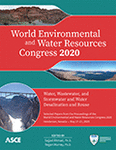World Environmental and Water Resources Congress 2020
Effect of Pyrolysis Temperature on Biochar Characteristics and Sorption
Publication: World Environmental and Water Resources Congress 2020: Water, Wastewater, and Stormwater and Water Desalination and Reuse
ABSTRACT
Warmer water temperatures and excessive nutrients transported by stormwater runoff create ideal conditions for harmful algal blooms (HABs). Climate change is lengthening warmer periods and accelerating the spread of HABs in surface waters around the world. Phosphate is a growth limiting nutrient for algae and reducing the amount of phosphate entering surface water could help in reduction of HABs. Carbon based sorbents such as biochar prepared from waste materials has shown potential for attenuating contaminants, including phosphates and other nutrients. But, limited research is conducted on effect of pyrolysis temperature and water temperature on removal of phosphates using biochar. In this study, biochar was prepared through pyrolysis of corn cob at 300, 400, and 500°C, and was washed with nitric acid to remove phosphorous inherently present in char and to activate it. The characteristics of char, organic carbon (loss of ignition), surface area analysis (BET), surface functional groups (FTIR) were determined. Batch isotherms and column experiments were performed at 10°C and 25°C to determine phosphate removal capacity. Under batch conditions at 25°C up to 1.89 mg/g of phosphate was removed whereas at 10°C lower removal up to 1.19 mg/g was achieved. Column tests at 25°C showed a 23.8% initial removal after a year of rain events, with 20.5% permanently removed (irreversible). At 10°C, a 21.8% initial removal was observed with 20.3% permanently removed. This paper will discuss the effect of pyrolysis temperature on characteristics of biochar and effect of water temperature on sorption.
Get full access to this article
View all available purchase options and get full access to this chapter.
REFERENCES
Anderson, D. M., Burkholder, J. M., Cochlan, W. P., Glibert, P. M., Gobler, C. J., Heil, C. A., Kudela, R., Parsons, M. L., Rensel, J. E. J., Townsend, D. W., Trainer, V. L., and Vargo, G. A. (2008). “Harmful algal blooms and eutrophication: Examining linkages from selected coastal regions of the United States.” Harmful algae, 8(1), 39–53.
Anderson, D. M., Hoagland, P., Kaoru, Y., and White, A. W. (2000). Estimated annual economic impacts from harmful algal blooms (HABs) in the United States. Woods Hole Oceanographic Institution, Woods Hole, MA.
Boesch, D. F., Brinsfield, R. B., and Magnien, R. E. (2001). “Chesapeake Bay eutrophication: scientific understanding, ecosystem restoration, and challenges for agriculture.” Journal of Environmental Quality, 30(2), 303–320.
Chintala, R., Schumacher, T. E., McDonald, L. M., Clay, D. E., Malo, D. D., Papiernik, S. K., Clay, S. A., and Julson, J. L. (2014). “Phosphorus Sorption and Availability from Biochars and Soil/Biochar Mixtures.” CLEAN – Soil, Air, Water, 42(5), 626–634.
Davis, A. P., Shokouhian, M., Sharma, H., and Minami, C. (2006). “Water quality improvement through bioretention media: nitrogen and phosphorus removal.” Water Environment Research: A Research Publication of the Water Environment Federation, 78(3), 284–293.
Eduah, J. O., Nartey, E. K., Abekoe, M. K., Henriksen, S. W., and Andersen, M. N. (2020). “Mechanism of orthophosphate (PO4-P) adsorption onto different biochars.” Environmental Technology & Innovation, 17, 100572.
Glibert, P.M., S. Seitzinger, C.A. Heil, J.M. Burkholder, M.W. Parrow, L.A. Codispoti, and V. Kelly. (n.d.). “The role of eutrophication in the global proliferation of harmful algal blooms.” Oceanography, 18(2):198–209.
Huang, Y., Lee, X., Grattieri, M., Yuan, M., Cai, R., Macazo, F. C., and Minteer, S. D. (2020). “Modified biochar for phosphate adsorption in environmentally relevant conditions.” Chemical Engineering Journal, 380, 122375.
Jiang, C., Li, J., Li, H., Li, Y., and Chen, L. (2017). “Field Performance of Bioretention Systems for Runoff Quantity Regulation and Pollutant Removal.” Water, Air, & Soil Pollution, 228(12), 468.
Sizmur, T., Fresno, T., Akgül, G., Frost, H., and Moreno-Jiménez, E. (2017). “Biochar modification to enhance sorption of inorganics from water.” Bioresource Technology, Special Issue on Biochar: Production, Characterization and Applications – Beyond Soil Applications, 246, 34–47.
Steffen, M. M., Davis, T. W., McKay, R. M. L., Bullerjahn, G. S., Krausfeldt, L. E., Stough, J. M. A., Neitzey, M. L., Gilbert, N. E., Boyer, G. L., Johengen, T. H., Gossiaux, D. C., Burtner, A. M., Palladino, D., Rowe, M. D., Dick, G. J., Meyer, K. A., Levy, S., Boone, B. E., Stumpf, R. P., Wynne, T. T., Zimba, P. V., Gutierrez, D., and Wilhelm, S. W. (2017). “Ecophysiological Examination of the Lake Erie Microcystis Bloom in 2014: Linkages between Biology and the Water Supply Shutdown of Toledo, OH.” Environmental Science & Technology, 51(12), 6745–6755.
Takaya, C. A., Fletcher, L. A., Singh, S., Anyikude, K. U., and Ross, A. B. (2016). “Phosphate and ammonium sorption capacity of biochar and hydrochar from different wastes.” Chemosphere, 145, 518–527.
US EPA, O. (2015). “A Compilation of Cost Data Associated with the Impacts and Control of Nutrient Pollution.” US EPA, Reports and Assessments, <https://www.epa.gov/nutrient-policy-data/compilation-cost-data-associated-impacts-and-control-nutrient-pollution> (Dec. 27, 2019).
Weiss Peter, T., Gulliver John, S., and Erickson Andrew, J. (2007). “Cost and Pollutant Removal of Storm-Water Treatment Practices.” Journal of Water Resources Planning and Management, 133(3), 218–229.
Yao, Y., Gao, B., Inyang, M., Zimmerman, A. R., Cao, X., Pullammanappallil, P., and Yang, L. (2011). “Removal of phosphate from aqueous solution by biochar derived from anaerobically digested sugar beet tailings.” Journal of Hazardous Materials, 190(1), 501–507.
Information & Authors
Information
Published In
World Environmental and Water Resources Congress 2020: Water, Wastewater, and Stormwater and Water Desalination and Reuse
Pages: 84 - 92
Editors: Sajjad Ahmad, Ph.D., and Regan Murray, Ph.D.
ISBN (Online): 978-0-7844-8298-8
Copyright
© 2020 American Society of Civil Engineers.
History
Published online: May 14, 2020
Published in print: May 14, 2020
Authors
Metrics & Citations
Metrics
Citations
Download citation
If you have the appropriate software installed, you can download article citation data to the citation manager of your choice. Simply select your manager software from the list below and click Download.
